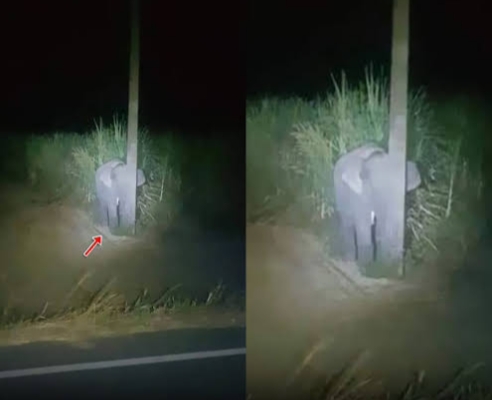Across a stretch of dusty farmland in rural Asia, mornings usually arrived quietly. Farmers walked the narrow paths between endless rows of sugarcane, listening to the soft rustle of leaves swaying with the breeze. Life there was simple, steady, and beautifully predictable—until the day a tiny wanderer disrupted the calm.
That morning, the farmers noticed something unusual before they even reached the fields. Several sugarcane stalks were snapped and scattered, and a few large footprints trailed through the soil. At first, they suspected a passing herd. But as they rounded a bend, the mystery solved itself in the most adorable way possible.
A baby elephant—round, wrinkled, and barely steady on its feet—stood in the middle of a toppled pile of sugarcane. It wasn’t just eating; it was celebrating. Its trunk swung clumsily as it grabbed stalk after stalk, stuffing sweet pieces into its mouth with the enthusiasm of a child discovering candy for the first time.

The calf had wandered off from its herd, led by curiosity and the rich smell of sugarcane drifting across the fields. To the little explorer, the green valley felt like paradise. To the farmers, it felt like catching a child with both hands in the cookie jar.
One of them cleared his throat. Another took a step forward. The baby elephant froze instantly.
Its ears stopped flapping. Its trunk hovered midair. Its eyes widened in a way that only innocence can achieve. Then, after a few tense seconds, the calf made a decision—one that would soon become legendary.
Instead of running back into the fields or trumpeting for help, it took a single, hesitant step backward. Then another. And with all the seriousness in the world, it shifted its entire round body behind the nearest object it could find: a skinny wooden pole.
The pole barely reached its chest. It covered nothing—not the elephant’s belly, not its swaying tail, not the top of its head peeking over like a child playing hide-and-seek. But the calf stood perfectly still, convinced that if it couldn’t see the farmers, they couldn’t see it.
The farmers burst into laughter. The scene was too pure, too unexpected, too deeply human in its clumsy logic. One snapped a photo. Another took a short video. Within hours, the images spread online, turning the baby elephant into an instant global star. People from every corner of the world shared the same reaction: joy.

Wildlife rangers arrived later that afternoon, following the farmers’ call. They approached slowly, careful not to frighten the calf further. It remained behind the pole, still committed to its hiding place. When the rangers gently guided it away, it hesitated as if debating whether the pole needed protection too.
Reunited with its herd, the baby elephant trotted nervously at first, then happily as its mother brushed a trunk over its back. The fields returned to normal, the farmers replaced the broken cane, and the moment passed into memory.
But online, the tiny elephant’s “invisibility trick” continued to spread. It became more than a funny story. It became a reminder of the innocence hidden in the wild, the humor nature gives without trying, and the small joys that still exist in everyday life.
Somewhere between those sugarcane rows, on that warm dusty morning, a baby elephant taught the world a simple truth: even in a vast and unpredictable world, happiness can appear in the most unexpected places—sometimes in the shape of a chubby calf hiding behind a stick.



